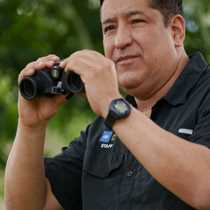We continued our expedition on this brand new day in the Upper Amazon in Peru. After a splendid breakfast, we visited the San Francisco community. We had a blast observing and experiencing firsthand how people live in the Amazon nowadays. Our visitors marveled at their intricate culture—it was fascinating to see how little things in life that we take from granted can mean so much for other people in a different environment.
The highlight of this cultural visit was that the town was celebrating the 41st anniversary of its foundation. All of the houses were ornamented with colorful banners and with the national red and white Peruvian flags. We were so lucky to be able to visit this community on such special day! In fact, we had a once in lifetime opportunity to see all of the preparations that go into these festivities. Many villagers were cooking food for more than five hundred people in a small hut. Lots of children were all around wearing their best clothing, and some were walking around with their native pets as well, including several juvenile brown three-toed sloths. Just like kids in cities have cats and dogs, children in the Amazon have native animals as pets. Our group of guests this week were part of the celebration as well, for they were named several times by the speakers. The local authorities thanked them for visiting the town, and even the local beauty queen showed up to share some time with our guests, who avidly took pictures of her.
We had a brief but emotive encounter with a welcoming committee formed by Minga Peru. This non-profit organization, founded in 1998, has the mission of promoting social justice and human dignity for women and families in the remote rural areas of the Peruvian Amazon. They have been developing various projects in the area.
Just few years ago, when Lindblad Expeditions started operating in the Upper Amazon in Peru, they created a fund together with National Geographic, called the LEX-NG Fund. In the Amazon, the fund will benefit the Minga Peru conservation initiatives that are and will be crucial to the long-term well-being of this amazing ecosystem and its inhabitants. Educational workshops focused on the protection of the environment and the development of leaders are being run. Radio programming is broadcast twice a week, reaching more than one hundred thousand inhabitants, focusing on the prevention of domestic violence, management of natural resources and health issues. This has become a popular way to reach the most remote communities in the area. Training women and community members in the technology of agroforestry, crop cultivation and the construction and management of fish ponds has proved to be invaluable to the objection of increasing the economical sustainability of many people.
Just minutes after we returned from our activities, we had a very special celebration. The ship was located in the famous confluence of the Marañon and Ucayali Rivers, the geographical place from where the Amazon River takes its name. We toasted to this event with a local Amazon drink!
In the early afternoon, as we were heading in the direction to our next visitors’ site, we had a photo presentation with our photo instructor, Jose Calvo. Once the talk was over we went for a swim in an idyllical lake, called Clavero. It was a lot of fun. We came back just in time to continue with the rest of the activities planned for the afternoon. The persistent, soft rain that we had experienced today dissipated just in time for a spectacular skiff ride, and a fiery sunset was a golden finale for an unforgettable day in the Amazon.







